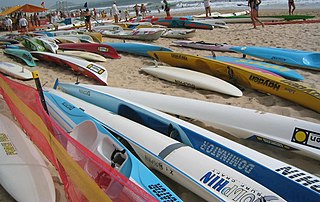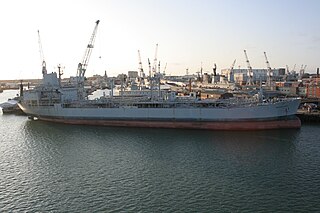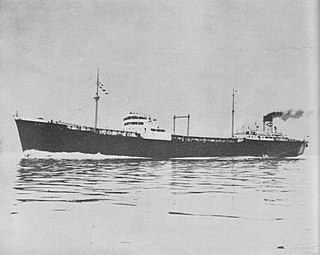
Surf lifesaving is a multifaceted social movement that comprises key aspects of voluntary lifeguard services and competitive surf sport. Originating in early 20th century Australia, the movement has expanded globally to other countries, including New Zealand, Ireland, South Africa, and the United Kingdom. Surf lifesavers in Australia are colloquially known as "Clubbies".

The Royal Fleet Auxiliary (RFA) is a naval auxiliary fleet owned by the UK's Ministry of Defence. It is a component of His Majesty's Naval Service and provides logistical and operational support to the Royal Navy and Royal Marines. The RFA ensures the Royal Navy is supplied and supported by providing fuel and stores through replenishment at sea, transporting Royal Marines and British Army personnel, providing medical care and transporting equipment and essentials around the world. In addition the RFA acts independently providing humanitarian aid, counter piracy and counter narcotic patrols together with assisting the Royal Navy in preventing conflict and securing international trade. They are a uniformed civilian branch of the Royal Navy staffed by British merchant sailors. The RFA is one of five RN fighting arms.
Operation Veritas was the codename used for British military operations against the Taliban government of Afghanistan in 2001. British forces played a supporting role to the American Operation Enduring Freedom. In addition, the British contribution was an important part of the overall forces deployed. Operation Veritas also incorporated Operation Oracle, Operation Fingal, and Operation Jacana. It was succeeded by Operation Herrick.

HMS Monmouth was the sixth "Duke"-class Type 23 frigate of the Royal Navy. She was the seventh ship to bear the name and was launched by Lady Eaton in 1991, being commissioned two years later.

RFA Grey Rover (A269) was a Rover-class small fleet tanker of the Royal Fleet Auxiliary (RFA). She was decommissioned in 2006.

The Armilla patrol was the name of the Royal Navy's permanent presence in the Persian Gulf during the 1980s and 1990s.

RFA Brambleleaf (A81) was a Leaf-class support tanker of the Royal Fleet Auxiliary (RFA), the naval auxiliary fleet of the United Kingdom. Originally built as MV Hudson Deep she was chartered by the Ministry of Defence (MoD) in 1980.
RFA Surf Pioneer (A365) was a Surf-class freighting tanker of the Royal Fleet Auxiliary. She and her sister RFA Surf Patrol were originally ordered by Polish owners but were commandeered by the Admiralty whilst building during the Korean War.

HMAS Choules (L100) is a Bay-class landing ship that served with the Royal Fleet Auxiliary (RFA) from 2006 to 2011, before being purchased by the Royal Australian Navy (RAN). The vessel was built as RFA Largs Bay by Swan Hunter in Wallsend, Tyne and Wear. She was named after Largs Bay in Ayrshire, Scotland, and entered service in November 2006. During her career with the RFA, Largs Bay served as the British ship assigned to patrol the Falkland Islands in 2008, and delivered relief supplies following the 2010 Haiti earthquake.

HMS Charybdis (F75) was a Leander-class frigate of the Royal Navy (RN). She was built by the Harland & Wolff company of Belfast, and was the last ship to be built there for British naval forces until RFA Fort Victoria of the Royal Fleet Auxiliary, was launched in 1990. Charybdis was launched on 28 February 1968 and commissioned on 2 June 1969. Her nickname was "Cherry B".

Standing Royal Navy deployments is a list of operations and commitments undertaken by the United Kingdom's Royal Navy on a worldwide basis. The following list details these commitments and deployments sorted by region and in alphabetical order. Routine deployments made by the Navy's nuclear-powered submarines and their location of operations is classified.

HMAS Westralia was a modified Leaf-class replenishment oiler which served with the Royal Australian Navy (RAN) from 1989 to 2006. Formerly RFA Appleleaf (A79), she served in with the British Royal Fleet Auxiliary (RFA) from 1975 to 1989. The ship was initially leased to the RAN, then purchased outright in 1994. In 1998, a fire onboard resulted in the deaths of four sailors. Westralia was decommissioned in 2006, and the ship was sold into civilian service for use as a Floating Production Storage and Offloading vessel, under the name Shiraz. However, the ship was laid up in Indonesia until late 2009, when she was sold to a Turkish ship breaking company. Arriving in January 2010, the vessel was scrapped.

RFA Wave Knight is a Wave-class fast fleet tanker of the Royal Fleet Auxiliary (RFA) of the United Kingdom tasked with providing fuel, food, fresh water, ammunition and other supplies to Royal Navy vessels around the world.
The Dale class consisted of three tankers chartered for service with the Royal Fleet Auxiliary (RFA), the naval auxiliary fleet of the United Kingdom. In 1967. They served for a number of years supporting Royal Navy and allied fleet operations, during which one, Ennerdale, was lost. The remaining two were returned to their original owners in the mid-1970s.

The Surf class were a class of replenishment oilers taken up for service with the Royal Fleet Auxiliary (RFA), supporting the Royal Navy during the Korean War. Two were commercial tankers under construction in British yards as the war began. A third ship was captured from in the Far East and brought into the RFA as Surf Pilot. She was never utilised however, and was laid up until being scrapped in 1960. The remaining two tankers were laid up at about this time, and were either sold or scrapped by 1970.

The bombing of RFA Fort Victoria took place on 6 September 1990, when a unit of the Provisional Irish Republican Army (IRA) planted two bombs aboard the Royal Fleet Auxiliary replenishment ship at Harland and Wolff shipyard in Belfast, Northern Ireland, where the vessel had been launched four months before. One of them exploded in the engine room, causing flooding and serious damage. The second device didn't explode and was defused several days later. The attack resulted in a two-year delay before Fort Victoria became fully operational.
RFA Darkdale was a Dale-class fleet tanker of the Royal Fleet Auxiliary (RFA), launched on 23 July 1940 as Empire Oil, completed in November 1940 and transferred to the RFA as Darkdale. She was sunk during the Second World War on 22 October 1941 by the German submarine U-68. Her wreck in James Bay off Jamestown, Saint Helena continued to leak oil, posing a potential environmental threat to the coastal waters of Saint Helena, until Ministry of Defence divers drained the ship's tanks in 2015.

Kuroshio Maru was a tanker that was built in 1938 for Japanese owners. She was chartered by the Imperial Japanese Navy and Imperial Japanese Army during World War II: the ship was sunk in January 1945 at Takao, Formosa by American aircraft. Salvaged in 1946, she was allocated as a war prize to China and renamed Yung Hao, but was forced to remain at Hong Kong by the British. She was requisitioned by the Admiralty during the Korean War and allocated to the Royal Fleet Auxiliary. She was to have been named RFA Surf Pilot but due to her poor condition she did not serve in the Royal Fleet Auxiliary. She served as Surf Pilot, a tender to HMS Terror until 1958 and was subsequently scuttled off Pulau Aur, Malaya in 1960.














